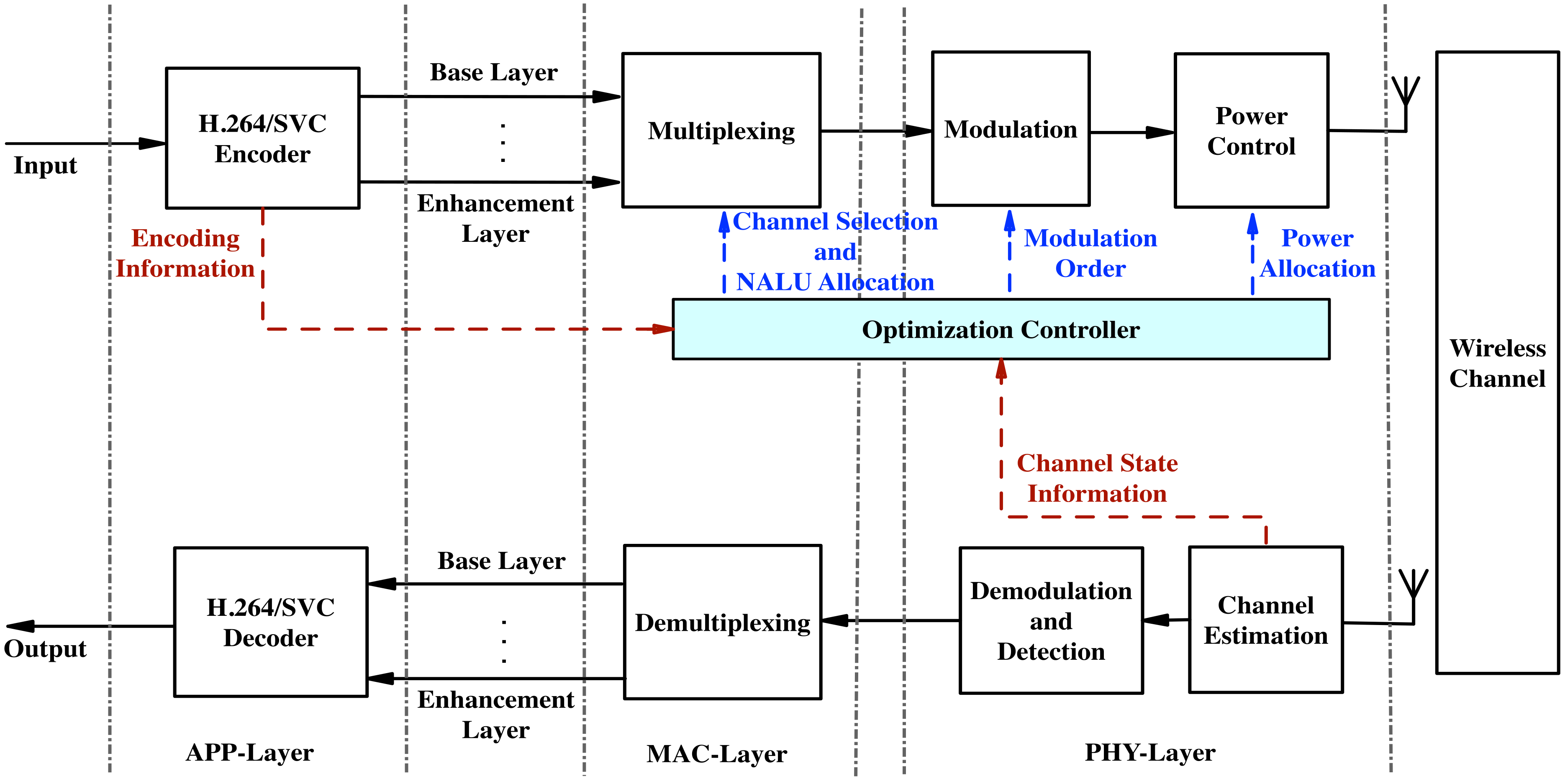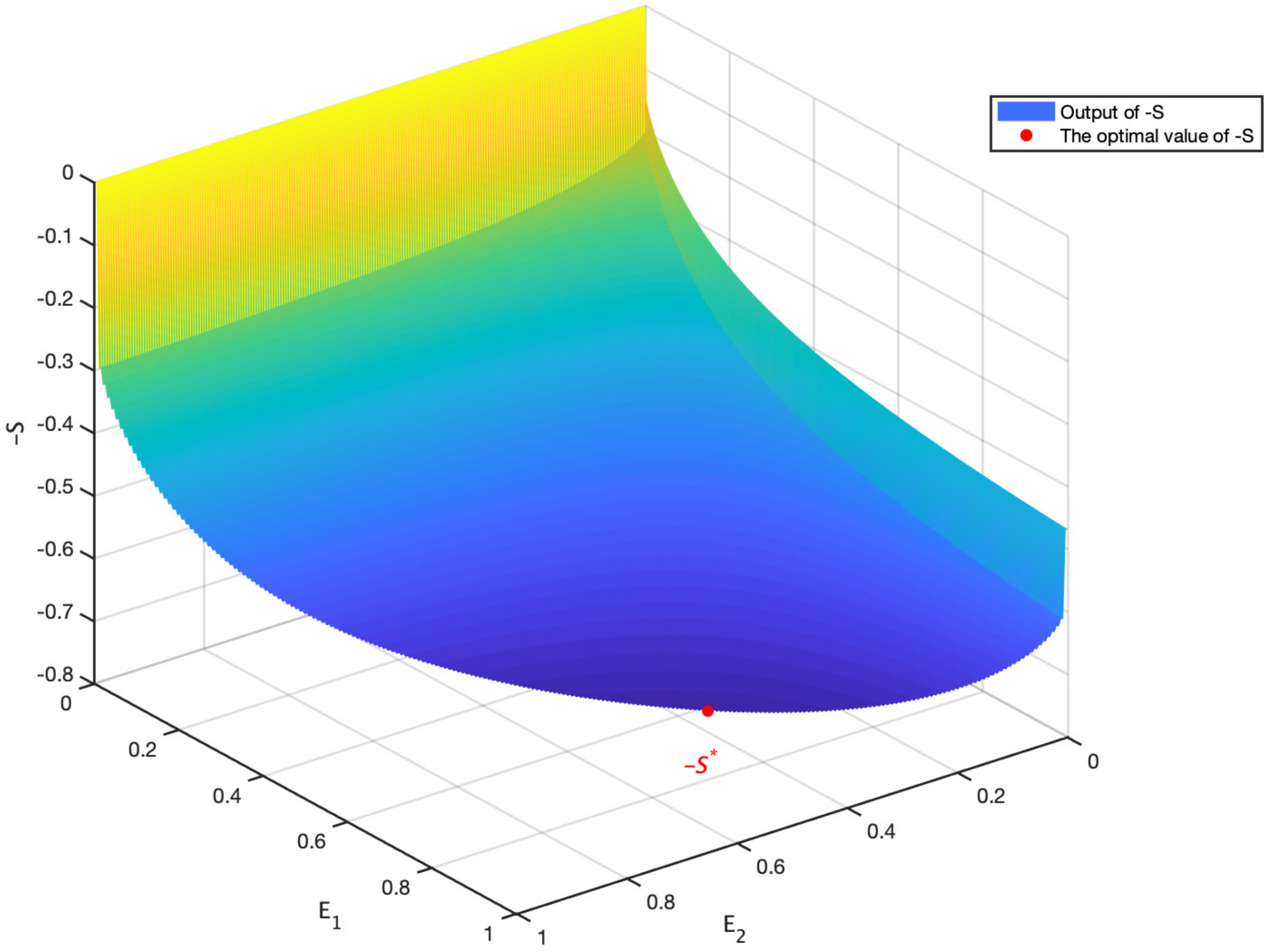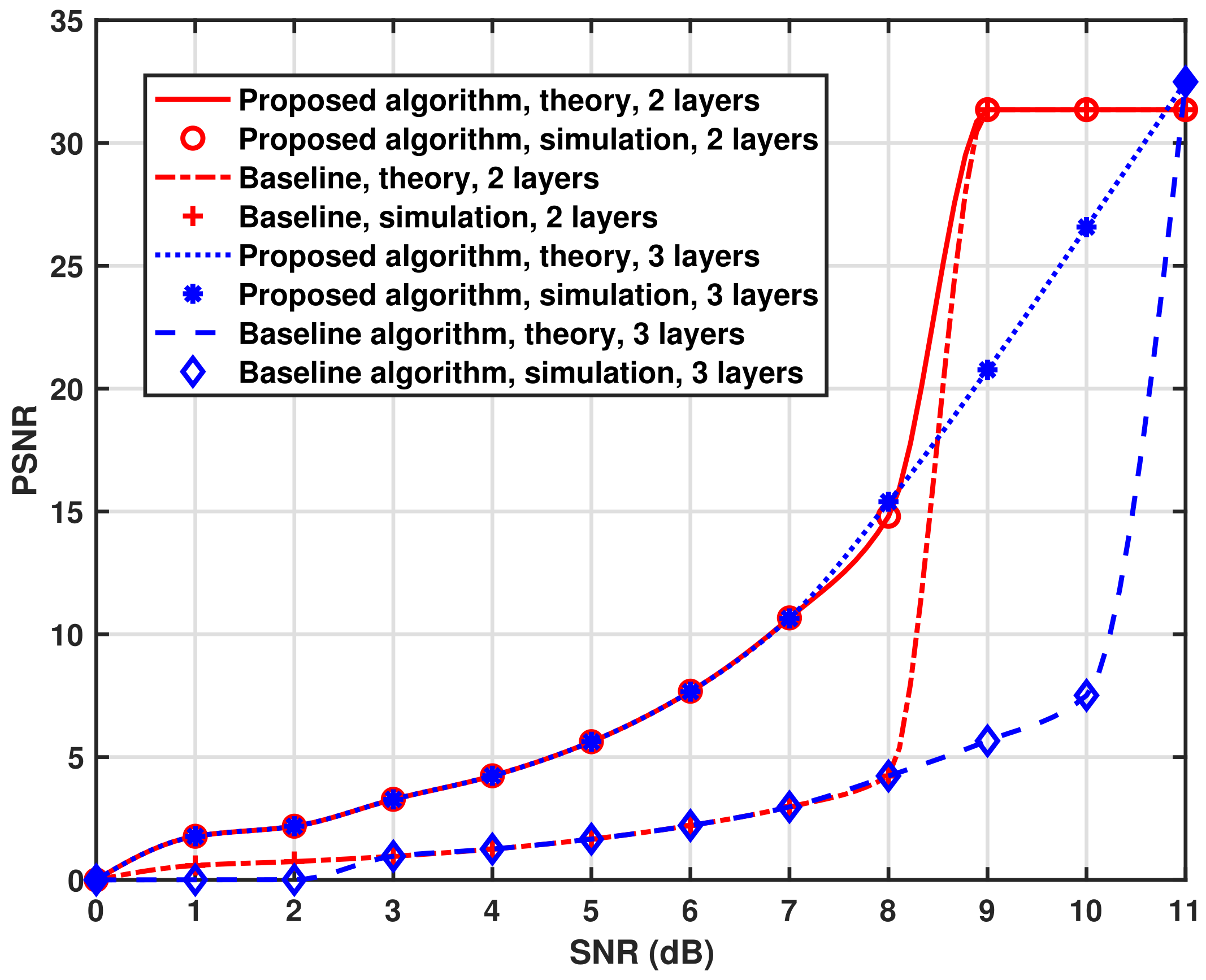Cross-Layer Optimization-Based Asymmetric Medical Video Transmission in IoT Systems
Abstract
1. Introduction
- (i)
- In the PHY- layer, the proposed strategy prefers the modulation and coding schemes (MCS) optimally, regarding the dynamical channel state information (CSI). Hence, our strategy could efficiently utilize the spectrum resources to transmit the video streams.
- (ii)
- In the MAC- layer, the video frame information in the APP- layer is employed as the control unit to replace the conventional video layer. Additionally, we propose to allocate the resource of MAC- layer with consideration of the video data priority. Such improvements ensure that the proposed strategy has higher adaptability than the related works [7,8,9,10,11,12,13,14,15,16].
- (iii)
- By characterizing the video transmission scheme in IoT networks, the proposed strategy is formulated by a quasi-convex problem. Thus, the strategy could achieve its optimum to ensure the video transmission efficiently.
2. System Model
3. Video Transmission Strategy
3.1. Problem Formulation
- 1.
- 2.
- 3.
- 4.
3.2. Strategy Design and Optimization for Asymmetric Video Transmissions
4. Simulation Results
5. Conclusions
Author Contributions
Funding
Data Availability Statement
Conflicts of Interest
Appendix A. Proof of Corollary 1
References
- Cisco Annual Internet Report 2018–2023, White Paper. Available online: https://www.cisco.com/c/en/us/solutions/collateral/executive-perspectives/annual-internet-report/white-paper-c11-741490.html (accessed on 1 August 2022).
- Convivas State of the Streaming TV Industry. Available online: https://www.conviva.com/research/convivas-state-streaming-tv-industry-q1-2022 (accessed on 1 August 2022).
- Sheng, M.; Han, W.; Huang, C.; Li, J.; Cui, S. Video delivery in heterogenous CRANs: Architectures and strategies. IEEE Wirel. Commun. 2019, 3, 14–21. [Google Scholar] [CrossRef]
- Wu, X.; Yang, J.; Ran, Y.; Xi, H. Adaptive scalable video transmission strategy in energy harvesting communication system. IEEE Trans. Multimed. 2015, 12, 2345–2353. [Google Scholar] [CrossRef]
- Maksymyuk, T.; Han, L.; Ge, X.; Chen, H.; Jo, M. Quasi-quadrature modulation method for power-efficient video transmission over LTE networks. IEEE Trans. Veh. Technol. 2014, 5, 2083–2092. [Google Scholar] [CrossRef]
- Zhang, B.; Cosman, P.; Milstein, L. Energy Optimization For Wireless Video Transmission Employing Hybrid ARQ. IEEE Trans. Veh. Technol. 2019, 6, 5606–5617. [Google Scholar] [CrossRef]
- Fang, T.; Chau, L.Q. GoP-based channel rate allocation using genetic algorithm for scalable video streaming over error-prone networks. IEEE Trans. Image Process. 2016, 6, 1323–1330. [Google Scholar]
- Zhang, D.; Li, H.; Chen, C.W. Robust transmission of scalable video coding bitstream over heterogeneous networks. IEEE Trans. Circuits Syst. Video Technol. 2015, 2, 300–313. [Google Scholar] [CrossRef]
- Song, D.; Chen, C.W. Scalable H.264/AVC video transmission over MIMO wireless systems with adaptive channel selection based on partial channel information. IEEE Trans. Circuits Syst. Video Technol. 2007, 17, 1218–1226. [Google Scholar] [CrossRef]
- Lu, H.; Jiang, X.; Chen, C.W. Distortion-Aware Cross-Layer Power Allocation for Video Transmission Over Multi-User NOMA Systems. IEEE Trans. Wirel. Commun. 2021, 2, 1076–1092. [Google Scholar] [CrossRef]
- Yang, J.; Xie, J.; Chen, S.; Wang, Z.; Hu, H.; Hanzo, L. Proportional-Fair Multi-User Scalable Layered Wireless Video Streaming Powered by Energy Harvesting. IEEE Trans. Veh. Technol. 2020, 4, 4460–4471. [Google Scholar] [CrossRef]
- Pudlewski, S.; Cen, N.; Guan, Z.; Melodia, T. Video transmission over lossy wireless networks: A cross-layer perspective. IEEE J. Sel. Top. Signal Process. 2015, 1, 6–21. [Google Scholar] [CrossRef]
- Zhong, H.; Wu, F.; Xu, Y.; Cui, J. QoS-Aware Multicast for Scalable Video Streaming in Software-Defined Networks. IEEE Trans. Multimed. 2021, 23, 982–994. [Google Scholar] [CrossRef]
- Dani, M.N.; So, D.K.C.; Tang, J.; Ding, Z. Resource Allocation for Layered Multicast Video Streaming in NOMA Systems. IEEE Trans. Veh. Technol. 2022, early access, 1–15. [Google Scholar] [CrossRef]
- Liu, W.; Zhang, H.; Ding, H.; Yuan, D. Delay and Energy Minimization for Adaptive Video Streaming: A Joint Edge Caching, Computing and Power Allocation Approach. IEEE Trans. Veh. Technol. 2022, 71, 9602–9612. [Google Scholar] [CrossRef]
- Zhang, X.; Wei, X.; Zhou, L.; Qian, Y. Social-Content-Aware Scalable Video Streaming in Internet of Video Things. IEEE Internet Things J. 2022, 9, 830–843. [Google Scholar] [CrossRef]
- Lin, K.; Dumitrescu, S. Cross-Layer resource allocation for scalable video over OFDMA wireless networks: Tradeoff between quality fairness and efficiency. IEEE Trans. Multimed. 2017, 17, 1654–1669. [Google Scholar] [CrossRef]
- Fang, S.; Chen, H.; Khan, Z.; Fan, P. User Fairness Aware Power Allocation for NOMA-Assisted Video Transmission With Adaptive Quality Adjustment. IEEE Trans. Veh. Technol. 2022, 71, 1054–1059. [Google Scholar] [CrossRef]
- Chen, X.; Hwang, J.; Ritcey, J.A. Quality-driven joint rate and power adaptation for scalable video transmissions over MIMO systems. IEEE Trans. Circuits Syst. Video Technol. 2017, 2, 366–379. [Google Scholar] [CrossRef]
- Lu, H.; Zhang, M.; Gui, Y.; Liu, J. QoE-Driven Multi-User Video Transmission Over SM-NOMA Integrated Systems. IEEE J. Sel. Areas Commun. 2019, 9, 2102–2116. [Google Scholar] [CrossRef]
- Gao, T.; Xiao, M.; Chen, P.; Gao, D. New Unequal Error Protection Strategy for Image Transmission Based on Bilayer-Lengthened PLDPC Code in Half-Duplex Relay System. Symmetry 2022, 14, 1662. [Google Scholar] [CrossRef]
- Stephen, B.; Vandenberghe, L. Convex Optimization; Cambridge University Press: Cambridge, UK, 2004. [Google Scholar]
- Standard Test Video Sequence Set. Available online: http://trace.eas.asu.edu/yuv/index.html (accessed on 1 August 2022).




| Input: | Maximum SVC layer: L |
| Possible modulation scheme | |
| System bandwidth: | |
| Output: | Optimal solution set: |
| 1. | Initialization: |
| 2. | For each modulation scheme |
| 3. | Calculate rate by (3)–(5); |
| 4. | Do power allocation and obtain ; |
| 5. | Consider asymmetric video structure and calculate by (9)–(12); |
| 6. | Obtain the minimum by (13) and (14); |
| Video | Layer 1 | Layer 2 | Layer 3 |
|---|---|---|---|
| Flower (Kbps) | 118 | 220 | 302 |
| Foreman (Kbps) | 109.875 | 223.035 | 350.49 |
Publisher’s Note: MDPI stays neutral with regard to jurisdictional claims in published maps and institutional affiliations. |
© 2022 by the authors. Licensee MDPI, Basel, Switzerland. This article is an open access article distributed under the terms and conditions of the Creative Commons Attribution (CC BY) license (https://creativecommons.org/licenses/by/4.0/).
Share and Cite
Wang, Y.; Han, W.; Ma, X.; Wang, Q.; Chen, F. Cross-Layer Optimization-Based Asymmetric Medical Video Transmission in IoT Systems. Symmetry 2022, 14, 2455. https://doi.org/10.3390/sym14112455
Wang Y, Han W, Ma X, Wang Q, Chen F. Cross-Layer Optimization-Based Asymmetric Medical Video Transmission in IoT Systems. Symmetry. 2022; 14(11):2455. https://doi.org/10.3390/sym14112455
Chicago/Turabian StyleWang, Yu, Weijia Han, Xiao Ma, Qiuzhi Wang, and Fengsen Chen. 2022. "Cross-Layer Optimization-Based Asymmetric Medical Video Transmission in IoT Systems" Symmetry 14, no. 11: 2455. https://doi.org/10.3390/sym14112455
APA StyleWang, Y., Han, W., Ma, X., Wang, Q., & Chen, F. (2022). Cross-Layer Optimization-Based Asymmetric Medical Video Transmission in IoT Systems. Symmetry, 14(11), 2455. https://doi.org/10.3390/sym14112455








